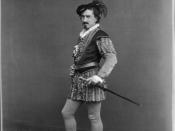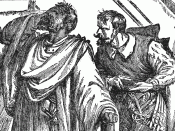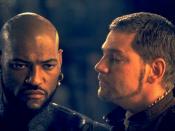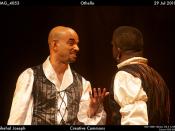There is a considerable difference between the spoken and written word. It is important to understand this difference to completely understand a piece of text. There are many facets that characterise these differences, but language is one of the most important. Goodman states that language is 'a map of the world' and rather represents things and events than watches them, as a one would when observing the outside world through a window. When a text is performed, it can be done so in many different forms, whereas a text can only be read. A performance is alive. It happens only once and cannot be stopped midway, as a book can be put aside. Esslin tells us that it is pace, rhythm, and variation in pitch and loudness that give each performance its unique quality. The language as performed gives so much information to the audience. It helps to develop characters, past events, action and materialises the dramatic word.
It is meaning that we are searching for, and all communication has meaning. Hawkes tells us that meaning resides in the total act of communication. It is not the message alone that gives the meaning. Factors such as addresser, addressee, contact, message, context and code all play a role in the total act of communication. Depending on which of these elements is more dominant in the communication that exposes the purpose or intention of the message.
Another set of aspects to consider is quantity, quality, relation and manner. This is in a sense more necessary to the writer, or speaker, but one must take it into account in order to gain the most from the encounter.
In a performance, the verbal element also functions as action. It is characters reactions to the words that play a large part in the action. One can make a study of the relationship between the action and text spoken. This can lead to interesting conclusions when one considers why the character's words contradict the action. This could possibly be used in order to reveal the character's complexity and mixed motivation without blatantly stating it through words. Subtlety is often the best option. It is often the best option to not repeat in your words what your actions are clearly stating. There is no point in saying you are making coffee when one can see that you are clearly doing so. Redundancy is unnecessary.
In social terms, in order to be successful in clearly getting one's message across, there are three conditions that must be adhered to. These conditions are (i) preparatory (ii) sincerity, and (iii) essential. In dramatic performances, abuse of these conditions is what gives drama its structure and so much of the structure is based thereupon. It is through this abuse that power and conflict are created - the driving force of the play. If a play's theme revolves around deception, it is likely to be highly dependent on such abuse of these conditions. There is a scene in Shakespeare's Othello that makes for an interesting study of all of these previously spoken about factors. This is Act III scene iii. This is the scene where Iago deceives Othello. It is possible for the audience to follow Iago's illocutionary (the act performed in saying -asking a question)-perlocutionary (performed by means of saying -persuasion) strategy. Here he performs a sequence of individual illocutions (i.e. when he repeats Othello's questions and never gives an answer leading Othello to believe his wife in unfaithful. Iago abuses the preparatory condition, as we know that he has no evidence on which to base his accusations/insinuations but has to rather create some, namely the handkerchief. Iago knows that what he is alluding to, is not true, but false. In a sense, his speech is contradictory to his action. The audience is aware of his deceit and yet he speaks with such honesty and loyalty to Othello. Iago, through his language, subtly places the seeds of jealousy in Othello's mind.
"O, beware, my lord, of jealousy! It is the green-eyed monster which doth mock the meat it feeds on." Iago speaks this to Othello before Othello has even thought about jealousy. He speaks of Desdemona's deceit when it is he that is deceiving.
"She did deceive her father in marrying you" In this scene we can get a better sense of Iago's character and ask the forever asked question, is Iago evil? Does Iago personify evil? We can see how he leads Othello astray with lies, or insinuations. It is here that the action really does begin. The plot action takes a drastic steep upturn as the tension is increased. Although the physical action on stage does add to the tension, without the words, they would not be nearly as powerful. Movement cannot express history. It is the language that defines the space. As the dialogue unfolds, the truth for the audiences rolls out. The visual action is framed by the words. Words carry power. Dialogues can convey so much about the relationship between two people. We can see that Othello loves and trusts Iago and if we hadn't any background to Iago's character, we would think the same of him. But we know him to be deceptive.
Another scene to look at would be from Steven Berkoff's Greek. There is a scene where a man is killed. Sounds normal enough. But this killing involved no physical contact. It was a fight of words. The words literally kill the manager and husband of his soon to be wife. In the performance, the visual images were superb in the way that the two fighters reacted to each other's attacks. The language is written in a way that is quite staggered and jerky. It is not in full sentences and gives a real feel for a fight. It gives one quite an insight into the character of Eddy and how he is a fighter and survivor and will get what he wants. The scene also relays past events of which the audience needed to be made aware. The event I speak of specifically is when Eddy's mother speaks of loosing her child and how it came to be. This is vital to the plot line.
The audience uses the text/speech and the visual images to attempt to receive the message being put across. Everyone reads the signs differently and may therefore get a different message, but they none-the-less take it all into account. It is vital to focus on all aspects in order to give an all-round performance that will be successful in its original mission - to communicate.




![From the Library of Congress: TITLE: Thos. W. Keene. Othello CALL NUMBER: POS - TH - 1884 .O7, no. 1 (C size) [P&P] REPRODUCTION NUMBER: LC-USZC6-58 (color film copy transparency) RIGHTS INFORMATION: No known restrictions on publication. MEDIUM: 1 print (](https://s.writework.com/uploads/9/94760/library-congress-title-thos-w-keene-othello-call-number-pos-thumb.jpg)